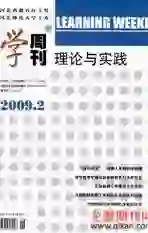定语从句难点解析
2009-06-01张磊
张 磊
摘要:英语高考必有的语法考查知识点之一就是定语从句。定语从句难就难在需要特殊注意的要点比较繁琐,而且跟其他从句容易混淆,不易辨别。为了比较容易地辨析定语从句,本文就定语从句的难点进行了解析。
关键词:定语从句;相关术语;解析
定语从句是整个高中英语教学课程的重点,也是高考必有的语法考查知识点。虽说平时对其的专题练习不少,但当考试时,学生还是失分较多,不得要领。实际上定语从句难就难在需要特殊注意的要点比较繁琐,而且跟其他从句容易混淆,不易辨别。所以我就定语从句的重难点进行解析,以期对各位读者能有所帮助。
一般做题之前要分析句子;对于难句子要把握好句子的成分,先把主干理出来,然后对照从句,看从句是名词性的还是形容词性的,如果是形容词性的就是定语从句了。定语从句一般都用来修饰主句中名词性成分。
重点分析:
一、定语从句及相关术语
1. 定语从句:修饰一个名词或代词的从句称为定语从句,一般紧跟在它所修饰的先行词后面。它是由关系代词和关系副词引导的从句,其作用是作定语修饰主句的某个名词性成分,定语从句分为限制性和非限制性从句两种。
关系词:引导定语从句的关联词称为关系词 。关系词有关系代词和关系副词。关系代词有that, which, who, whom, whose, as等;关系副词有where, when, why等。关系词常有3个作用:1. 引导定语从句。2. 代替先行词。3. 在定语从句中担当一个成分。
二、具体分析
(A)限制性定语从句
限制性定语从句与主句的关系很紧凑,对其先行词起限定、修饰的作用。如果将其去掉,会影响句子意思的完整性;有时甚至于引起费解、误解。
(B)非限制性定语从句:非限制性定语从句的作用是对所修饰的成分作进一步说明,非限制性定语从句在形式上就与主句很松散,它与主句之间有一个逗点“,”隔开;它对其先行词没有限定、修饰的作用,只起补充、说明的作用。有时也用它来对全句进行补充、说明。即使将其去掉,也不会影响句子意思。由于上述原因,非限制性定语从句在表达意思方面也有别于限制性定语从句。另外,非限制性定语从句在中文译文里,which引导的非限制性定语从句用来说明前面整个句子的情况或主句的某一部分,所以我们往往将其作为一个分句处理,而不把它作定语翻译。
具体举例分析:
要注意区分以下两个句子的不同。
(1) His brother who is now a doctor always encourages him to go to college.
他那当医生的哥哥常鼓励他要考上大学。(他还有其他的哥哥)
(2) His brother, who is now a doctor, always encourages him to go to college.
他的哥哥是当医生的,常鼓励他要考上大学。(他只有一个哥哥)
注:①限制性定语从句与②非限制性定语从句之间的区别:
1. 形式上。①不用逗号和主句隔开,②用逗号和主句隔开
2. 意义上。①是先行词不可缺少的定语,不能删除,②是对先行词的补充说明,删除后意思仍完整
3. 译法上。①翻译成先行词的定语,“…的…”,②通常翻译成主句的并列句
4. 关系词的使用上。限定性定语从句:A.作宾语时可省略B.可用that C.可用who代替whom;非限定性定语从句:A.不可省略 B.不用that C.不用who代替whom。
(C)关系词:分为关系代词和关系副词两类。
1. that既可代表事物也可代表人,which代表事物;它们在从句中作主语或宾语,that在从句中作宾语时常可省略,which在从句中作宾语则不能省略。而且,如果which在从句中作“不及物动词+介词”的介词的宾语,注意介词不要丢掉,而且介词总是放在关系代词which的前边,但有的则放在原来的位置
2. which作宾语时,根据先行词与定语从句之间的语义关系,先行词与which之间的介词不能丢
3. 代表事物时多用which,但在带有下列词的句子中用that而不用which,这些词包括all, anything, much等,这时的that常被省略
4. who和whom引导的从句用来修饰人,分别作从句中的主语和宾语,whom作宾语时,要注意它可以作动词的宾语也可以作介词的宾语
5. where是关系副词,用来表示地点的定语从句
6. when引导定语从句表示时间
7. whose是关系代词,修饰名词作定语,相当于所修饰成分的前置所有格
8. 当从句的逻辑主语是some, any, no, somebody, anybody, nobody, something, anything, everything或nothing时,常用there is来引导关系代词引导的定语从句
具体举例分析:
(a)关系代词引导定语从句。
1. who指人,在从句中作主语。
The boys who are playing football are from Class One.
Yesterday I helped an old man who lost his way.
2. whom指人,在从句中作宾语,常可省略。
Mr. Liu is the person (whom) you talked about on the bus.
注意:关系代词whom在口语和非正式语体中常用who代替,可省略。
The man who/whom you met just now is my friend.
3. which指事物,在从句中作主语或者宾语,作宾语时可省略。
Football is a game which is liked by most boys.
This is the pen (which) he bought yesterday.
如果在从句中作宾语,就用whom或who。比如:
He is the man whom/who I talk to.
如果在从句中作主语就只能用who。比如:
He is the man who has an English book.
4. that指人时,相当于who或者whom;指物时,相当于which。在从句中作主语或者宾语,作宾语时可省略。
The number of the people that/who come to visit the city each year rises one million.
Where is the man that/whom I saw this morning?
5. whose通常指人,也可指物,在从句中作定语。
He has a friend whose father is a doctor.
I once lived in a house whose roof has fallen in.
whose指物时,常用以下结构来代替:
The classroom whose door is broken will soon be repaired.
The classroom the door of which is broken will soon be repaired.
Do you like the book whose cover is yellow?
Do you like the book the color of which is yellow?
(b) 关系副词引导的定语从句。
1. when指时间,在定语从句中作时间状语。
I still remember the day when I first came to the school.
The time when we got together finally came.
2. where指地点,在定语从句中作地点状语。
Shanghai is the city where I was born.
The house where I lived ten years ago has been pulled down.
3. why指原因,在定语从句中作原因状语。
Please tell me the reason why you missed the plane.
I dont know the reason why he looks unhappy today.
注意:关系副词引导的从句可以由“介词+关系代词”引导的从句替换。
The reason why/for which he refused the invitation is not clear.
From the year when/in which he was going to school he began to know what he wanted when he grew up.
(c)介词+关系代词引导的定语从句。
关系代词在定语从句中作介词宾语时,从句常由介词+关系代词引导。
The school (that/which) he once studied in is very famous.
The school in which he once studied is very famous.
Well go to hear the famous singer (whom/that/who) we have often talked about.
Well go to hear the famous singer about whom we have often talked.
注意:1. 含有介词的动词短语一般不拆开使用,如:look for, look after, take care of等。
This is the watch which/that I am looking for. (T)
This is the watch for which I am looking. (F)
2. 若介词放在关系代词前,关系代词指人时用whom,不可用who或者that;指物时用which,不能用that;关系代词是所有格时用whose。
The man with whom you talked is my friend. (T)
The man who/that you talked with is my friend. (F)
The plane in which we flew to Canada is very comfortable. (T)
The plane in that we flew in to Canada is very comfortable. (F)
3.“介词+关系代词”前可有some, any, none, both, all, neither, most, each, few等代词或者数词。
He loved his parents deeply, both of whom are very kind to him.
In the basket there are quite many apples, some of which have gone bad.
There are forty students in our class in all, most of whom are from big cities.
(d) as和which引导的定语从句。
as和which引导非限制性定语从句,有相同之处也有不同之处。具体情况是:
1. as和which都可以在定语从句中作主语或者宾语,代表前面整个句子。
He married her, as/which was natural.
2. as 引导非限制性定语从句,可放在主句之前,或者主句之后,甚至可以切割一个主句;which引导的非限制性定语从句只能放在主句之后。另外,as有“正如……,正像……”的意思。
As is known to all, China is a developing country.
John, as you know, is a famous writer.
He has been to Paris more than several times, which I dont believe.
注意:当主句和从句存在逻辑上的因果关系时,常用which。
Tom was always late for school, which made his teacher angry.
3. 当先行词受such, the same修饰时,常用as。
He is not such a fool as he looks.
This is the same book as I lost last week.
注意:当先行词由the same修饰时,偶尔也用that引导定语从句,但是和由as所引导的定语从句意思不同。
She wore the same dress that she wore at Marys wedding. 她穿着她在玛丽婚礼上穿过的一条裙子。
She wore the same dress as her young sister wore. 她穿着和她妹妹所穿的一样的裙子。
4. 以the way为先行词的定语从句通常由in which, that引导,而且通常可以省略。
The way in which/that he answered the question was surprising.
5. but有时也可以作关系词引导定语从句。
There are very few but understand his idea. (but=who dont)
难点分析:
一、限制性定语从句只能用that的几种情况:
1.当先行词是anything, everything, nothing (something 除外), few, all, none, little, some等代词时,或者是由every, any, all, some, no, little, few, much等修饰时。
Have you taken down everything that Mr. Li has said?
There seems to be nothing that seems impossible for him in the world.
All that can be done has been done.
There is little that I can do for you.
注意:当先行词指人时,偶尔也可以用who。
Any man that/who has a sense of duty wont do such a thing.
2. 当先行词被序数词修饰:
The first place that they visited in London was the Big Ben.
3. 当先行词被形容词最高级修饰时:
This is the best film that I have seen.
4. 当形容词被the very, the only 修饰时:
This is the very good dictionary that I want to buy.
After the fire in his house, the old car is the only thing that he owned.
当先行词指人时,偶尔也可以用who。
Wang Hua is the only person in our school who will attend the meeting.
5. 当先行词前面有who, which等疑问代词时:
Who is the man that is standing there?
Which is the T-shirt that fits me most?
6. 当先行词既有人,也有动物或者物体时:
Can you remember the scientist and his theory that we have learned?
二、区分定语从句和同位语从句
1. 定语从句修饰先行词,它和先行词是修饰关系;同位语从句说明先行词的具体内容,是补充说明的关系。
The plane that has just taken off is for London.定语从句
The fact that he has been dead is clear. 同位语从句
2. 定语从句由关系代词或者关系副词引导,关系词在句中充当成分,有时可以省略;同位语从句主要由that引导,在句中一般不充当成分;句子也可以由when, where, how, why, whether, what等词引导,充当成分。
The news he told me is true.
The news that he has just died is true.
The problem that we are facing now is how we can collect so much money.
The problem how we can collect so much money is difficult to solve.
3. 同位语从句和先行词一般可以用be动词发展成一个完整的句子,而定语从句不可以。
The idea that we could ask the teacher for advice is wonderful.
The idea was that we could ask the teacher for advice.
The fact that the earth moves around the earth is known to all.
The fact is that the earth moves around the earth.
